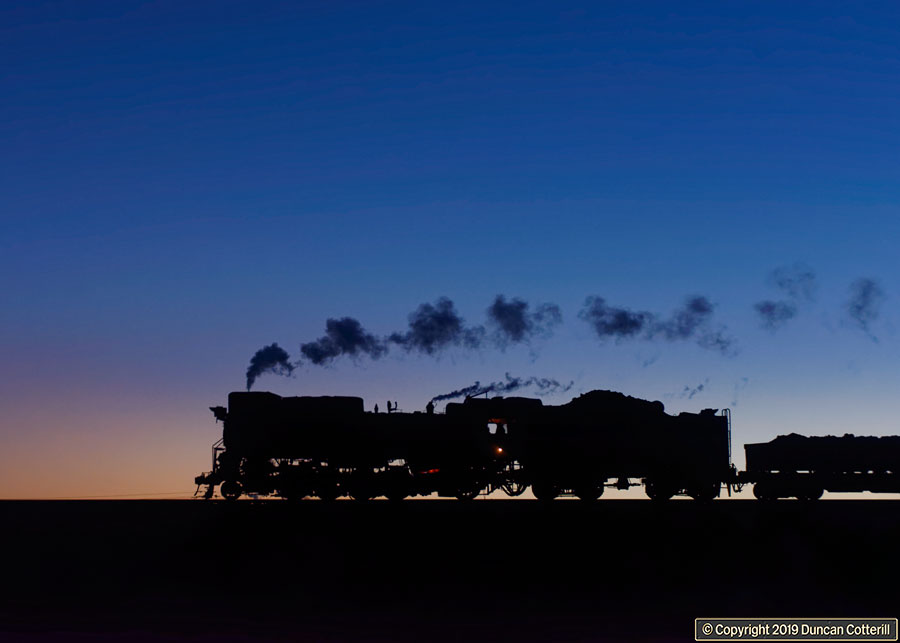ANOTHER FLING TO SANDAOLING
one more visit to China's last big user of steam locomotives
China - 19 November to 3 December 2018 - Report by Duncan Cotterill
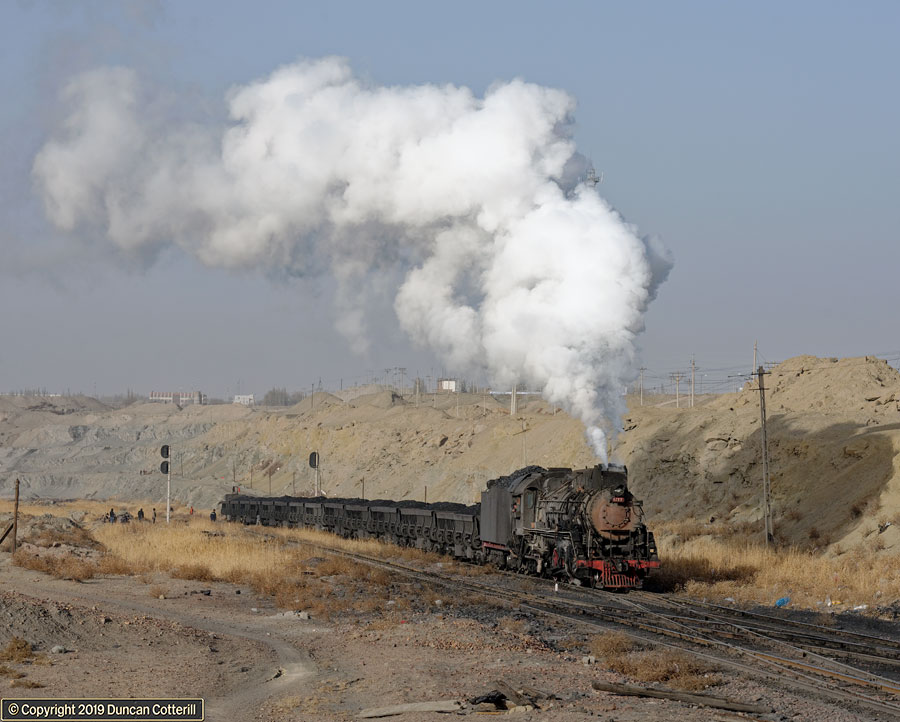
Over The Top
JS.8197 dragged a loaded coal train into Kengkouzhan on the afternoon of 26 November 2018. Normally locos would have shut off by this point but, on this occasion, the train had been held beyond the signals for half an hour until a track gang had completed their work. The combination of a cold engine and a restart on the gradient produced just enough exhaust to blot out the unsightly communications masts behind.INTRODUCTION
2018 was a busy and difficult year for me, with little time for railway activities, but I did manage to fit in a trip to China for a steam fix towards the end of the year. This report covers a 10 day visit to the Sandaoling Mining Railway in China’s far west in late November and early December 2018. We were at Sandaoling from midday on Wednesday 21 November to midday on Saturday 1 December.OPENCAST MINE OPERATIONS
Railway operations in the opencast mine were significantly reduced compared to the previous year. Our first few days were particularly quiet with between 2 and 4 loaded trains out of the pit between 10:00 and 18:30. Traffic levels picked up markedly during the last few days of November with 8 to 10 loaded trains over the same period each day. On our last morning, 1st December, things seemed to have quietened down again, so the surge may well have been something to do with achieving monthly output targets.At Xikeng the two outer tracks have been taken out of use with stop blocks installed a short distance from the points at the Ba’erzhan end of the yard. The northernmost of the two remaining lines was being used to load trains by front-end loader from a huge pile of coal covering what had been the through line to Xibolizhan until a few years ago.
The other remaining line was used to access the blue loader and to coal the locos. It’s possible that a few trains were loaded by front-end loader on this line as well but we weren’t close enough to any of them to be absolutely sure.
The area once occupied by the closed siding to the south was being used to load large lorries by front-end loader. These appeared to take out the equivalent of at least 4 trainloads per day.
The other remaining line was used to access the blue loader and to coal the locos. It’s possible that a few trains were loaded by front-end loader on this line as well but we weren’t close enough to any of them to be absolutely sure.
The area once occupied by the closed siding to the south was being used to load large lorries by front-end loader. These appeared to take out the equivalent of at least 4 trainloads per day.
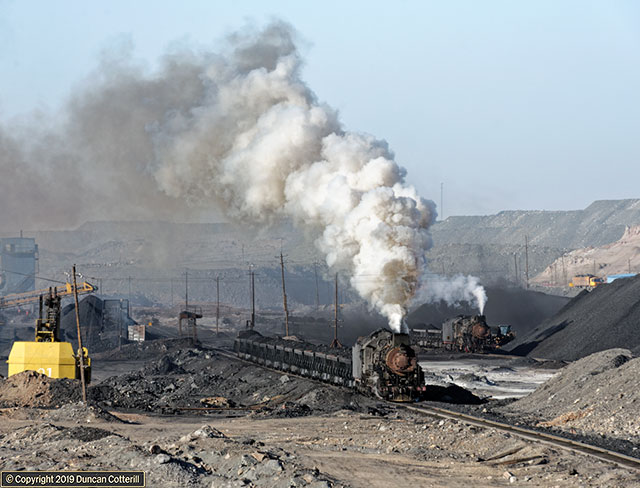
All Change at Xikeng
JS 8173 departed Xikeng with a train from the blue loader on 30 November 2018.On the right, JS.8197 waited for its train to be loaded from the large pile of coal behind.
Of the four lines in service the previous year, only the two occupied by trains in this picture still remained in use.
To the right of JS.8197 a yellow lorry can be seen making its way out of the pit, one of many now handling coal traffic that had previously been on the railway.
In general, trains loaded at the blue loader went to the Xuanmeichang washery while those loaded by shovel went via Dongbolizhan and round the double horseshoe curves to the unloading point at Jianmeixian, west of Nanzhan. Jianmeixian had been reported as closed earlier in the year but that certainly wasn't the case during our visit.
Whereas last year there were periods when the blue loader was turning out trains every 30 minutes, the best it achieved this year was a train every 45 minutes and it never kept going at that rate for very long. Sometimes trains could be sitting under the loader for 3 or 4 hours before they were ready to go, particularly in mid-afternoon.
Shovel loading times also varied considerably but usually when a train went to the shovels, loading started within a few minutes and kept going until the job was finished. The longest loading time we saw was over 90 minutes, when a single shovel was working. With 2 shovels in use it could take less than half that time. Getting a train underway from the shovels usually involved a lot of slipping, with noise and towering exhaust to match, but they always got going eventually without assistance.
The number of trains serving either destination varied considerably from day to day but overall about 60% went to the washery. The shovels seemed to stop loading around 16:00 and after that everything went to the washery. At no point did we see any CNR wagons on the opencast system so the plan to load these at Xikeng appears to have been shelved.
Whereas last year there were periods when the blue loader was turning out trains every 30 minutes, the best it achieved this year was a train every 45 minutes and it never kept going at that rate for very long. Sometimes trains could be sitting under the loader for 3 or 4 hours before they were ready to go, particularly in mid-afternoon.
Shovel loading times also varied considerably but usually when a train went to the shovels, loading started within a few minutes and kept going until the job was finished. The longest loading time we saw was over 90 minutes, when a single shovel was working. With 2 shovels in use it could take less than half that time. Getting a train underway from the shovels usually involved a lot of slipping, with noise and towering exhaust to match, but they always got going eventually without assistance.
The number of trains serving either destination varied considerably from day to day but overall about 60% went to the washery. The shovels seemed to stop loading around 16:00 and after that everything went to the washery. At no point did we see any CNR wagons on the opencast system so the plan to load these at Xikeng appears to have been shelved.
One Off The Shovels
After a pair of front end loaders had finished shovelling coal into the wagons, JS.8195 got its train underway around midday on 30 November 2018.This train was bound for the Jianmeixian unloading point near Nanzhan, the destination for most of the coal loaded here.
The loader produced very uniform loads with few sizeable lumps while the shovels produced less regular piles with many more large lumps, making it relatively easy to tell where a train had loaded.
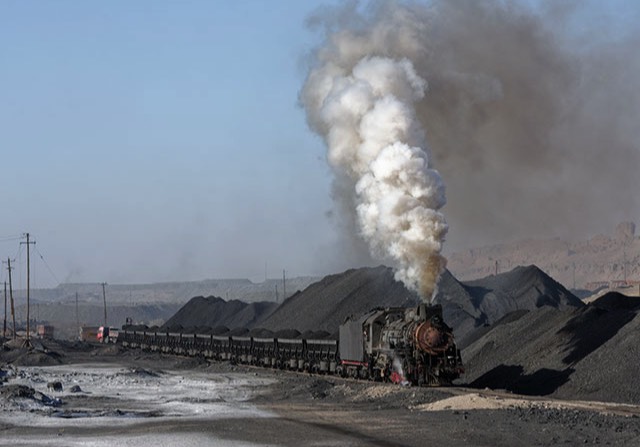
Only 3 locos were in service at any one time, with JS 8167, 8195 and 8197 in use when we arrived. On the first Friday JS 8173 replaced JS 8195 and on the second Friday JS 8195 replaced JS 8197.
The locos were generally in worse condition than last year but still cabable of doing the job.
JS 8197, which had been the worst loco in traffic a couple of years ago now seemed much more capable.
JS 8173 seemed particularly prone to slipping during the first few days but miraculously became as sure-footed as the others later on. It appears the improvement was simply due to a different driver at the regulator.
JS 8195 was very offbeat, sounding like a 3-cylinder loco with a missing cylinder. Despite this, it still seemed capable of the task in hand.
JS 8167 was still the best of the bunch but not quite the superb machine it had been a few years ago and now filthy dirty as well.
Overall, the locos weren’t being worked quite as hard as in previous years but they weren’t being mollycoddled by any means and still sounded good when they were thrashed.
The locos were generally in worse condition than last year but still cabable of doing the job.
JS 8197, which had been the worst loco in traffic a couple of years ago now seemed much more capable.
JS 8173 seemed particularly prone to slipping during the first few days but miraculously became as sure-footed as the others later on. It appears the improvement was simply due to a different driver at the regulator.
JS 8195 was very offbeat, sounding like a 3-cylinder loco with a missing cylinder. Despite this, it still seemed capable of the task in hand.
JS 8167 was still the best of the bunch but not quite the superb machine it had been a few years ago and now filthy dirty as well.
Overall, the locos weren’t being worked quite as hard as in previous years but they weren’t being mollycoddled by any means and still sounded good when they were thrashed.
The morning gathering at Dongbolizhan for shift change was much less rewarding than last year. The “passenger” duty continued to operate but the loco tended to leave Dongbolizhan well before first light and wait for its customer(s) at Kengkouzhan. It also returned to Dongbolizhan much earlier, arriving around 08:40 or 08:45 on most days.
With only three trains in operation, all could stable on roads equipped with water columns, so there was no longer any need for the fourth train to work forward to the headshunt at sunrise and then reverse onto a line where it could take water.
There was also a long rake of spare wagons parked in the middle of the yard, making silhouette shots of trains on the southernmost of the three water column equipped roads difficult. The other two locos still stopped under the hideous lighting tower at the west end of the yard, making good pictures almost impossible.
With only three trains in operation, all could stable on roads equipped with water columns, so there was no longer any need for the fourth train to work forward to the headshunt at sunrise and then reverse onto a line where it could take water.
There was also a long rake of spare wagons parked in the middle of the yard, making silhouette shots of trains on the southernmost of the three water column equipped roads difficult. The other two locos still stopped under the hideous lighting tower at the west end of the yard, making good pictures almost impossible.
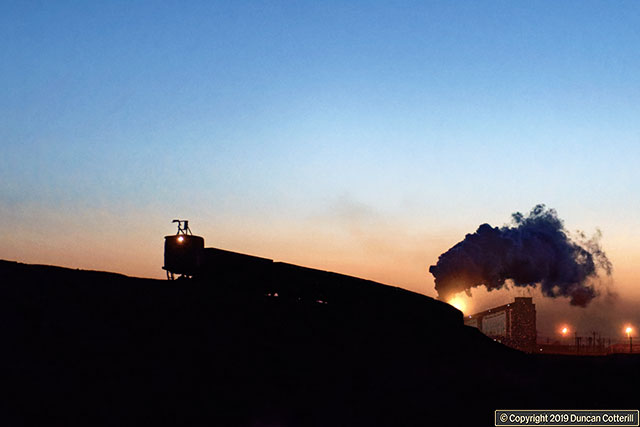
The End of the Night Shift
Chinese drivers always seem to drive more vigorously when it's time to go home. That applies whether they're driving a steam loco or a minibus full of gricers.The driver of JS.8195 was certainly going for it as he worked the last train of his shift from Xuanmeichang towards Dongbolizhan and shift change.
A cascade of sparks from the chimney can just be seen silhouetted against the silos on the right. Sunrise was still 40 minutes away but the last full day of our visit had just got off to a good start.
On a couple of occasions loaded trains must have reached the washery shortly before shift change but been unable to unload in time. When this happened the loco uncoupled and ran light to Dongbolizhan before returning to its train after shift change. On one occasion the light loco even ran to Xikeng to coal before going back to its train.
The first set of empties usually left Dongbolizhan between 09:10 and 09:30, with a second set following around 20 to 30 minutes later. The third set could follow 20 to 30 minutes after that or it might be very much later if there wasn’t a lot of coal to shift.
The first loaded train out of the pit would generally be sometime between 10:30 and 11:30 usually, but not always, from the blue loader.
As noted in my previous reports, regulation of trains still leaves a lot to be desired with loaded trains frequently being held unnecessarily at the signals at Ba’erzhan or Kengkouzhan and then having to restart.
The first set of empties usually left Dongbolizhan between 09:10 and 09:30, with a second set following around 20 to 30 minutes later. The third set could follow 20 to 30 minutes after that or it might be very much later if there wasn’t a lot of coal to shift.
The first loaded train out of the pit would generally be sometime between 10:30 and 11:30 usually, but not always, from the blue loader.
As noted in my previous reports, regulation of trains still leaves a lot to be desired with loaded trains frequently being held unnecessarily at the signals at Ba’erzhan or Kengkouzhan and then having to restart.
Early Light
JS.8167 basked in weak early morning sunlight at Dongbolizhan on 27 November 2018. The loco was waiting its turn to set back and take water before returning to work in the opencast mine.In the distance JS.8173 set off for the pit after filling its tender. Once it was clear, JS.8167 would get the signal to move.
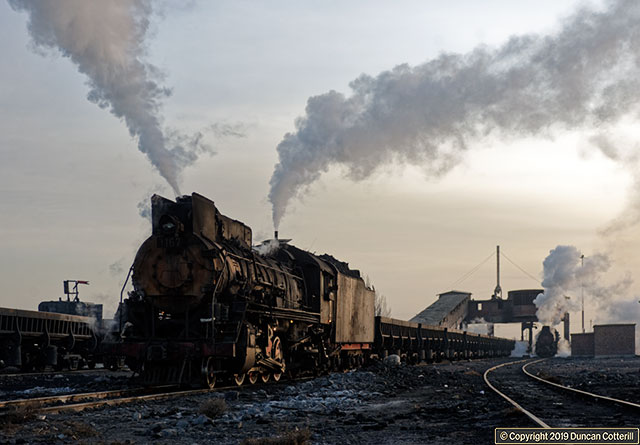
DEEP MINE SYSTEM (Nanzhan)
We hardly spent any time here as Nanzhan doesn’t have the same photographic potential as the opencast system and security seemed to be much tighter.There were some officious security bods, armed with cudgels, keeping people away from Nanzhan itself and even the public level crossing at the east end of the yard. In addition, the main security checkpoint on the road to Liushuquan was right by the level crossing on the line to Erjing. That shouldn’t have been a problem in itself but getting back in could have made a trip out that way very time consuming.
We did visit Yijing on two occasions and found JS 8053 on a short train being loaded by shovel on the first visit. The coal appeared to be brought in by the same type of lorry that was being loaded at Xikeng but could have come from somewhere else as we never ascertained that they were the same lorries.
JS 8053 was the only Nanzhan loco we positively identified but we did see a couple of other JS from too far away to read their numbers. Unidentified DF8B diesels were also seen on a couple of occasions on the line to Liushuquan and heard several times on the line to Shadunzi.
JS 8053 was the only Nanzhan loco we positively identified but we did see a couple of other JS from too far away to read their numbers. Unidentified DF8B diesels were also seen on a couple of occasions on the line to Liushuquan and heard several times on the line to Shadunzi.
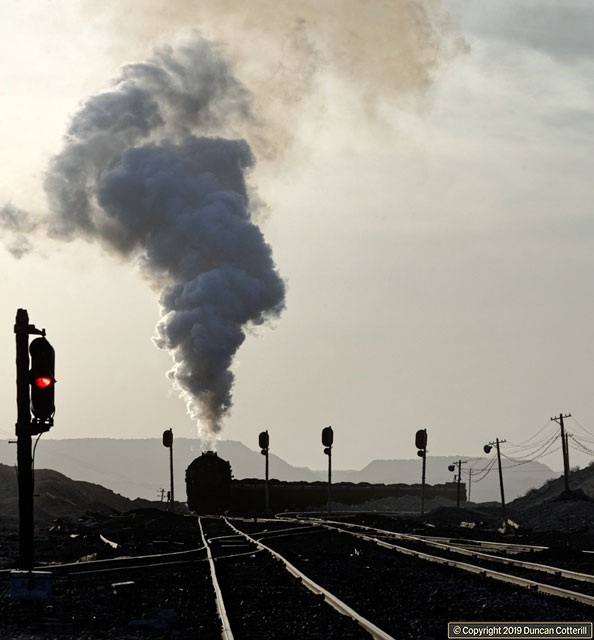
Blasting Through Ba'erzhan
JS.8197 made heavy weather of its departure from Xikeng on the afternoon of 27 November 2018.The loco was photographed passing the signals at the west end of Ba'erzhan at walking pace as the sun struggled to break through the clouds.
TRAVEL ARRANGEMENTS
Flights from London to Beijing and back were with British Airways aboard Boeing 787-900s both ways ( G-ZBKI out on 19 November and G-ZBKS back on 3 December, if anyone’s interested).On the outward leg we stayed in Beijing overnight before continuing by air to Hami on an Air China Boeing 737 on the morning of 21 November.
On the return journey we had planned to spend two nights in Beijing, between arriving from Hami on 1 December and departing for the UK on 3 December, but a powerful storm over north-west China closed Hami airport on the afternoon we were due to fly and our flight back to Beijing was delayed until the following morning. If we hadn’t had the extra day in Beijing as a buffer we’d have missed our flights home.
SECURITY IN XINJIANG
Security had been tightened considerably since the previous year. As well as petrol stations, most banks and public buildings had substantial steel barriers outside and there were magnetic and x-ray scanners and security guards in stab vests and steel helmets in the entrances of hotels and restaurants.There were police everywhere, many of them armed, and checkpoints at the entrance to every town, including Sandaoling. Our documents were thoroughly scrutinised and the details recorded on arrival at Hami airport and on entering Sandaoling from the expressway. It was all very polite and relaxed but quite intimidating in its way.
All the extra checks were very time consuming. Getting from the airport to the hotel in Sandaoling took the best part of an hour longer than usual.
On the positive side, the authorities didn’t seem in the slightest bit concerned that we were in Sandaoling to photograph the steam locomotives at the opencast mine and we were never challenged whilst in or around the pit.
WEATHER
After last year’s clear light, this visit was a bit disappointing weather wise. There was a lot more cloud this time and the air was much hazier, obscuring views of the Tianshan to the north. It wasn’t cloudy all the time and we did get a few largely sunny days but the sunrises and sunsets were generally underwhelming.Temperatures were low enough to ensure good exhausts, apart from one afternoon when the clag was getting thin by Ba’erzhan and evaporated completely long before the loco topped the bank at Kengkouzhan. It was never really uncomfortably cold, even before dawn at Dongbolizhan.
During our stay at Sandaoling there were two major duststorms, a type of weather I hadn’t experienced there before.
The first started in the early hours of the Sunday morning and lasted until lunchtime. We set off for Dongbolizhan in the morning, as usual, but soon turned back and returned to the hotel until things had calmed down. After the storm there still appeared to be a lot of dust in the atmosphere, limiting visibility. At least it should help produce a colourful sunset we thought, but no, it was amongst the most colourless I think I’ve ever seen.
The second storm arrived on the second Saturday, just as we were about to leave for Hami Airport. Our driver thought the expressway might be closed so we set off via the back road to Liushuquan.
Conditions were horrendous with almost zero visibility in places. Dust, sand and small pebbles crashed into the side of the vehicle and sheets of plastic flew across the road at a much greater speed than we were managing.
All of a sudden it stopped, just as we were passing Liushuquan station. The wind dropped to almost nothing and the rest of the journey was uneventful. About 40 minutes after we arrived at the airport the storm caught us up and it was about 7 hours before things began to calm down again, by which time our flight had been cancelled until the following day.
The first started in the early hours of the Sunday morning and lasted until lunchtime. We set off for Dongbolizhan in the morning, as usual, but soon turned back and returned to the hotel until things had calmed down. After the storm there still appeared to be a lot of dust in the atmosphere, limiting visibility. At least it should help produce a colourful sunset we thought, but no, it was amongst the most colourless I think I’ve ever seen.
The second storm arrived on the second Saturday, just as we were about to leave for Hami Airport. Our driver thought the expressway might be closed so we set off via the back road to Liushuquan.
Conditions were horrendous with almost zero visibility in places. Dust, sand and small pebbles crashed into the side of the vehicle and sheets of plastic flew across the road at a much greater speed than we were managing.
All of a sudden it stopped, just as we were passing Liushuquan station. The wind dropped to almost nothing and the rest of the journey was uneventful. About 40 minutes after we arrived at the airport the storm caught us up and it was about 7 hours before things began to calm down again, by which time our flight had been cancelled until the following day.
BEER
After the trains, the most important thing on any trip is the availability of decent beer. For some people it's the other way round. Chinese beers aren't renowned for their quality and, around 15 years ago, breweries changed from brewing honest but underwhelming weak ale to producing a fizzy chemical liquid from which all traces of taste had been carefully removed. Well, things have taken a turn for the better, in Beijing at least. The discovery of the trip was a craft beer establishment within staggering distance of Liangmaqiao subway station, also the location of the Lufthansa Centre and the Paulaner Brauhaus. Great Leap Brewing is at 45-1 Xinyuan St and has a varied selection of tasty beers and does food as well. Head west from the subway station for half a km along Xinyuan South Road then turn north up Xinyuan St for 350m and you will see the bar a few metres along a side street on your left.Pushing Back
JS.8167 pushed back from Dongbolizhan towards Kengkouzhan on its way down into the pit after shift change on 29 November 2018.Even with an empty train, the climb out of Dongbolizhan was steep enough to make the engines work hard and occasionally the first train of the morning would slip to a stand and have to make a second run at the bank.
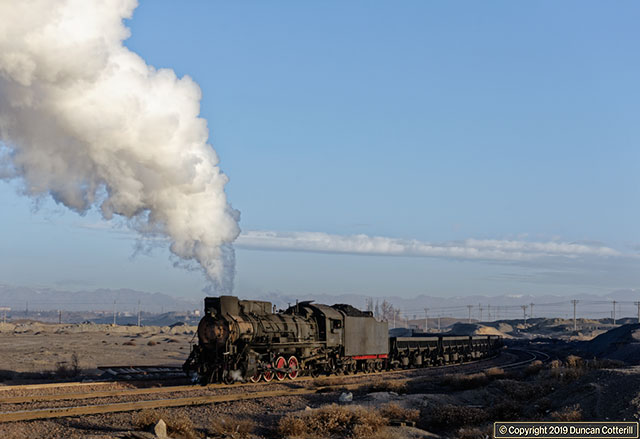
Comments and Conclusions
After a disappointing start, the trip got much better towards the end, with more good light and far more trains. Even so, after 11 trips to Sandaoling, I’m not sure I’ll want to go back again next year.Until last year there were always changes from one year to the next, some good and others bad, but always some new opportunities that hadn’t been there before.
There was nothing new last year but, with good weather and lots of traffic, Sandaoling was just a great place to be, with never a dull moment and lots of scope for good shots.
This year things have changed again but invariably for the worse. Shift change at Dongbolizhan is a shadow of its former self and the long periods of inactivity in the pit soon get very tedious.
With the workshops and Nanzhan out of bounds and the line to Erjing outside the security cordon the number of places to photograph is more limited than ever and new shots were almost impossible to find.
Sandaoling is also becoming very popular with Chinese enthusiasts as well as general tourists and photographers. While I welcome their interest in steam, it does make it difficult to get good shots when there are loads of people wandering around in brightly coloured clothing and spending ages photographing every rivet on the engine from close up.
Many of them seem oblivious of the dangers of a working railway and will happily stand in the four-foot snapping away, a couple of feet ahead of a loco that’s about to move and almost certainly out of sight of the crew. If some idiot gets themselves killed or seriously injured, the mine will probably stop access for everyone, including those of us who act responsibly.
The additional security didn’t really cause us any major problems but just made it more time consuming getting around and made speculative visits to the mediocre locations on the Nanzhan system more hassle than they were worth.
Maybe it’s time to call it a day and recognise that Sandaoling’s finest days are over and the best shots I’m going to get there are already in the bag. Maybe a few months away from real working steam will change my mind, or maybe not, we’ll just have to see.
Many of them seem oblivious of the dangers of a working railway and will happily stand in the four-foot snapping away, a couple of feet ahead of a loco that’s about to move and almost certainly out of sight of the crew. If some idiot gets themselves killed or seriously injured, the mine will probably stop access for everyone, including those of us who act responsibly.
The additional security didn’t really cause us any major problems but just made it more time consuming getting around and made speculative visits to the mediocre locations on the Nanzhan system more hassle than they were worth.
Maybe it’s time to call it a day and recognise that Sandaoling’s finest days are over and the best shots I’m going to get there are already in the bag. Maybe a few months away from real working steam will change my mind, or maybe not, we’ll just have to see.
